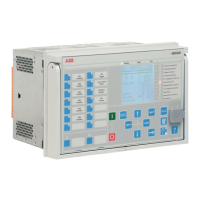Because the decrease of frequency indicates a need to reduce the load, it is
practical to connect the start signal of an underfrequency function block to the
RSV digital input.
It depends on the load characteristics how much the load is reduced as the voltage
drops. For instance, purely resistive loads are proportional to the square of the
voltage, whereas motor drives based on frequency controllers may draw constant
power despite small voltage changes.
The status of the RSV input can be read from the RSV input data.
9.5.4.6 Automatic voltage regulation of parallel transformers
It is likely that a circulating current between transformers occurs if two or more
transformers with slightly different ratios are energized in parallel. This is due to
the unbalanced short circuit impedances of the parallel transformers. To avoid
such currents, the tap changers of the transformers should be adjusted to achieve
equilibrium. If the transformers are assumed identical, the tap (voltage) steps
and tap positions should also match. In this case, the Master/Follower principle
can be used. However, unequally rated transformers with different tap steps can
be connected in parallel and these configurations can also be managed by the
tap changer control function. For these configurations, the Minimizing Circulating
Current (MCC) or Negative Reactance Principle (NRP) should be used. The MCC and
NRP principles are also suitable for identical transformers.
The circulating current, which is almost purely inductive, is defined as negative if
it flows towards the transformer. U
ci
in
Equation 184
is positive and the control
voltage U
p
rises as a result to the RAISE_OWN output signal activation if the
circulating current level is sufficient (
Equation 187
and
Equation 189
) and the
other parameters remain the same. As a result, the voltage rise should diminish
the circulating current.
LDC equation and parallel connection
The additional challenge in the parallel connection regarding the line drop
compensation is to know the total current which flows through the parallel
transformers.
In the Master/Follower mode, it is easier to know the total current than in other
parallel modes since the transformers are assumed to have identical ratings,
that is, the total current (I
injected
in
Equation 186
) is obtained by multiplying
the measured load current (the average of the secondary currents I_A, I_B and
I_C of the connected own transformer) with the number of parallel transformers.
OLATCC can internally conclude the number of parallel transformers from the
connected tap changer position inputs. However, if there is no connected position
information from the other parallel transformers, the correct number of the parallel
transformers, excluding the own transformer, needs to be set with the
Parallel
trafos
setting.
In the MCC mode, the horizontal communication transfers the information from
the measured load currents between the regulators so that the total current
needed in the line drop compensation can be summed accurately. Here, I
injected
is defined to be the phasor sum of all the parallel power transformer secondary-side
currents. The currents from other transformers must be fed via the TRx_I_AMPL
and TRx_I_ANGL inputs.
In the NRP mode, the parallel transformers have different ratings and there is no
communication between the regulators. Therefore, when setting
Line drop V React
Control functions
1MRS757644 H
1054 620 series
Technical Manual

